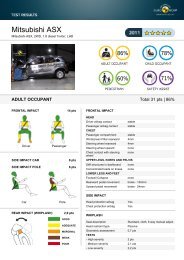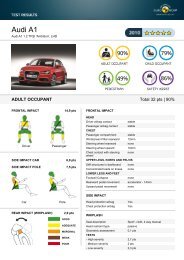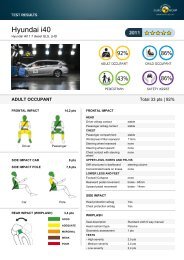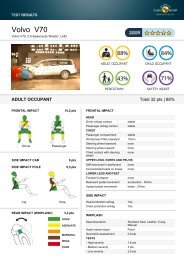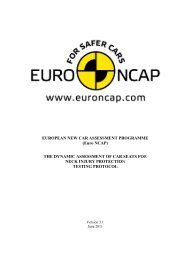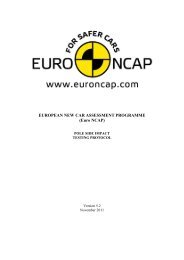Pedestrian Test Protocol - Euro NCAP
Pedestrian Test Protocol - Euro NCAP
Pedestrian Test Protocol - Euro NCAP
Create successful ePaper yourself
Turn your PDF publications into a flip-book with our unique Google optimized e-Paper software.
7 RECORDING THE IMPACT POINT LOCATIONS<br />
7.1 General<br />
7.1.1 A three dimensional measuring system with an accuracy of 0.5mm shall be used to<br />
record the grid origin and the points chosen for test. For the Bumper and Bonnet<br />
Leading Edge record the position of the impact point placed on the Upper Bumper<br />
Reference Line and the Bonnet Leading Edge Reference Line respectively, at the<br />
chosen lateral test positions. For the bonnet top, A-pillar, windscreen and roof record<br />
the position of markers placed on the selected impact points.<br />
7.1.2 Care should be taken at all times not to move the vehicle while the impact points are<br />
being recorded or transferred.<br />
7.2 Measuring Impact Points<br />
7.2.1 Ensure that the vehicle is at its test weight and fully test prepared as defined in Section<br />
1.<br />
7.2.2 Measure the ride heights at all four wheels using the marks defined in Section 1.3.4.<br />
Record the ride heights in the test details.<br />
7.2.3 During digitising, care should be taken not to move the vehicle by, for example, leaning<br />
on it.<br />
7.2.4 The co-ordinates of all impact locations should be digitised with the 3D arm. For each<br />
of the bonnet leading edge locations, record both the co-ordinates of the location and<br />
that point on the Upper Bumper Reference Line in the same longitudinal vertical plane<br />
as it.<br />
7.2.5 A hard copy of the impact points’ co-ordinates should be obtained for reference.<br />
7.2.6 After digitisation, the bonnet top and bumper featuring all the impact points shall be<br />
removed and replacements fitted. See Section 8.3 for fitting procedures.<br />
7.2.7 The original bonnet and bumper shall be kept for reference and will be replaced on the<br />
vehicle once testing is complete.<br />
7.3 Transferring Impact Points to Replacement Vehicle Parts<br />
7.3.1 Replacement parts will need to be fitted to the vehicle for the series of tests. It is not<br />
practical to have to mark out each of the parts completely for a single test. Therefore,<br />
the original marked-out bonnet will be retained as a reference and individual impact<br />
locations transferred to replacement components.<br />
7.3.2 With the new component(s) fitted, measure the ride heights at all four wheels.<br />
7.3.3 These ride heights must be altered until they match the original recorded ride heights<br />
(Section 1.3). If the ride heights are too high then they can be reduced by adding<br />
weights. If the ride heights are too low then they can be increased by removing weight<br />
from the vehicle and/or inserting blocks under the body of the vehicle. The additional<br />
weights and/or blocks shall be removed before testing.<br />
7.3.4 Set up the 3D measuring system.<br />
7.3.5 Using the co-ordinates recorded in Section 7.2 for the original impact points, locate and<br />
mark the desired impact point on the new component.<br />
Version 7.0<br />
March 2013<br />
31



